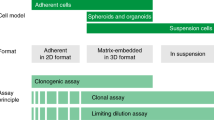Abstract
Clonogenic assay or colony formation assay is an in vitro cell survival assay based on the ability of a single cell to grow into a colony. The colony is defined to consist of at least 50 cells. The assay essentially tests every cell in the population for its ability to undergo “unlimited” division. Clonogenic assay is the method of choice to determine cell reproductive death after treatment with ionizing radiation, but can also be used to determine the effectiveness of other cytotoxic agents. Only a fraction of seeded cells retains the capacity to produce colonies. Before or after treatment, cells are seeded out in appropriate dilutions to form colonies in 1–3 weeks. Colonies are fixed with glutaraldehyde (6.0% v/v), stained with crystal violet (0.5% w/v) and counted using a stereomicroscope. A method for the analysis of radiation dose–survival curves is included.


Similar content being viewed by others
References
Puck, T.T. & Markus, P.I. Action of X-rays on mammalian cells. J. Exp. Med. 103, 653–666 (1956).
Brown, J.M. & Attardi, L.D. The role of apoptosis in cancer development and treatment response. Nat. Rev. Cancer 5, 231–237 (2005).
Hall, E.J. Radiobiology for the Radiobiologist. (JB Lippincott Company, Philadelphia, 2000).
Till, J.E. & McCulloch, E.A. A direct measurement of the radiation sensitivity of normal mouse bone marrow. Radiat. Res. 14, 213–222 (1961).
Reinhold, H.S. Quantitative evaluation of the radiosensitivity of cells of a transplantable rhabdomyosarcoma in the rat. Eur. J. Cancer 2, 33–42 (1966).
Steel, G.G. Basic Clinical Radiobiology. 3rd edn. (Arnold, London, 2002).
Freshney, R.I. Culture of Animal Cells, A Manual of Basic Technique. 2nd edn. (Alan R. Liss Inc., New York, 1987).
Van Bree, C., Castro Kreder, N., Haveman, J. and Franken, N.A.P. Statistical analysis of radiation survival curves using SPSS (Chicago, IL, USA) statistical software. http://www.amc.nl/index.cfm?sid=817.
Van Bree, C., Franken, N.A.P., Rodermond, H.M., Stalpers, L.J. & Haveman, J. Repair of potentially lethal damage does not depend on functional TP53 in human glioblastoma cells. Radiat. Res. 161, 511–516 (2004).
Barendsen, G.W., Van Bree, C. & Franken, N.A.P. Importance of cell proliferative state and potentially lethal damage repair on radiation effectiveness: implications for combined tumor treatments. Review. Int. J. Oncol. 19, 247–256 (2001).
Barendsen, G.W. Parameters of linear-quadratic radiation dose–effect relationships: dependence on LET and mechanisms of reproductive cell death. Int. J. Radiat. Biol. 71, 649–55 (1997).
Acknowledgements
We thank Professor Dr. G.W. Barendsen for his invaluable contribution.
Author information
Authors and Affiliations
Corresponding author
Ethics declarations
Competing interests
The authors declare no competing financial interests.
Rights and permissions
About this article
Cite this article
Franken, N., Rodermond, H., Stap, J. et al. Clonogenic assay of cells in vitro. Nat Protoc 1, 2315–2319 (2006). https://doi.org/10.1038/nprot.2006.339
Published:
Issue Date:
DOI: https://doi.org/10.1038/nprot.2006.339
- Springer Nature Limited
This article is cited by
-
Combining a noble gas with radiotherapy: glutamate receptor antagonist xenon may act as a radiosensitizer in glioblastoma
Radiation Oncology (2024)
-
PLK4 as a potential target to enhance radiosensitivity in triple-negative breast cancer
Radiation Oncology (2024)
-
Antiproliferative activities of some selected Nigerian medicinal plants against breast, liver, and cervical cancer cells
BMC Complementary Medicine and Therapies (2024)
-
α-Ketoglutarate supplementation and NAD+ modulation enhance metabolic rewiring and radiosensitization in SLC25A1 inhibited cancer cells
Cell Death Discovery (2024)
-
Germline specific genes increase DNA double-strand break repair and radioresistance in lung adenocarcinoma cells
Cell Death & Disease (2024)





